25 photos of the cosmos that will leave you awestruck
Science
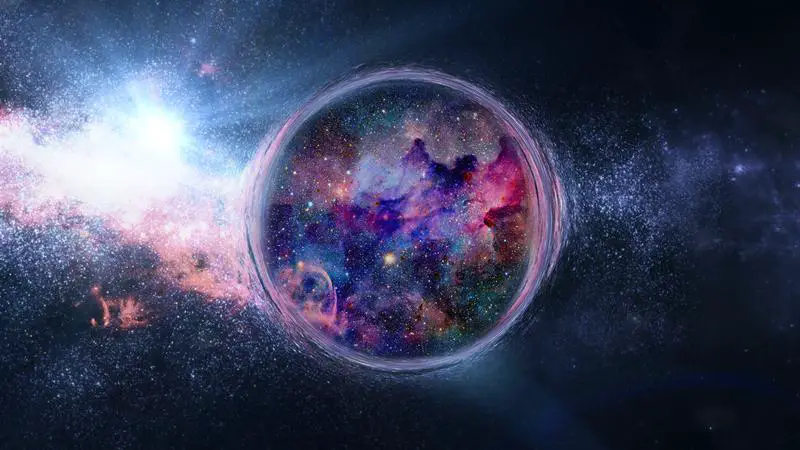
1. Horsehead Nebula
Curiosity
Nothing is more relentlessly weird than space. While the deepest waters might hold some of the strangest creatures, and the distant past some of the oddest adaptations, nothing calls into question our view of reality—and life in it—as reliably as space. And so, here we look at a snapshot of the grandeur inherent to space. We look at exploded stars, galaxy clusters, and blurs that represent far-off light warping through spacetime. This brief sojourn into the celestial will really put us in our place—cosmically, that is.
The horsehead nebula is a part of the constellation Orion, which lies somewhere around 1,500 light years from Earth. It was first documented at the Harvard Observatory in 1888, making it one of the earlier identified nebulas. The red of the nebula is due to the thick hydrogen gas within it.
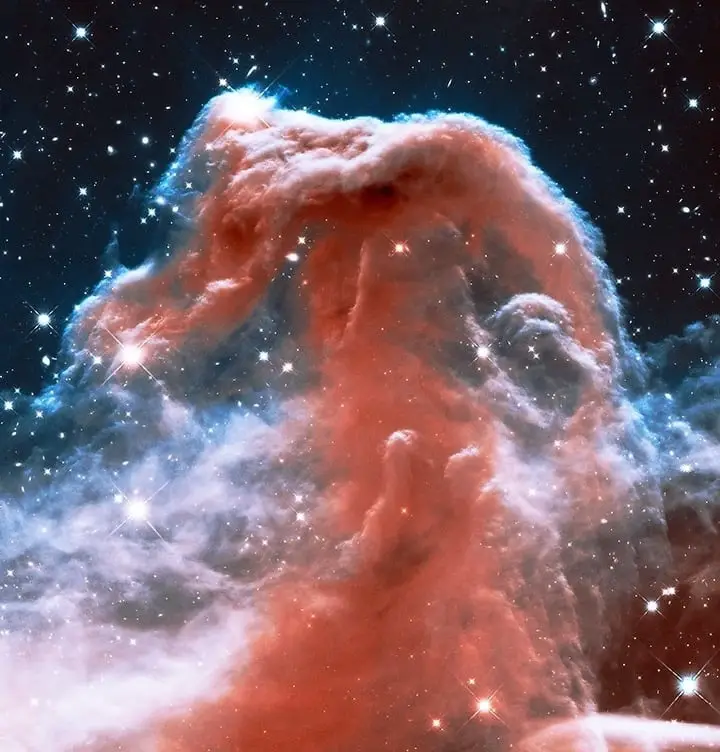
Redbubble
Other than hydrogen, this galactic stallion is comprised of hundreds of other gases. But to get us this image, this particular view of the nebula is created with infrared light; it subtracts many of the conflicting frequencies we would otherwise see. Without this infrared imagery, the nebula would appear much more lackluster than it currently is.
2. What is a nebula?
Nebula is Latin for “cloud” or “fog.” Basically, it just means there’s a large aggregation of gases or dust in space—often times in the process technically known as “diffuse,” meaning that they don’t have any clearly defined boundaries. They spread, in other words, from one section of space to another in diffuse gradations.
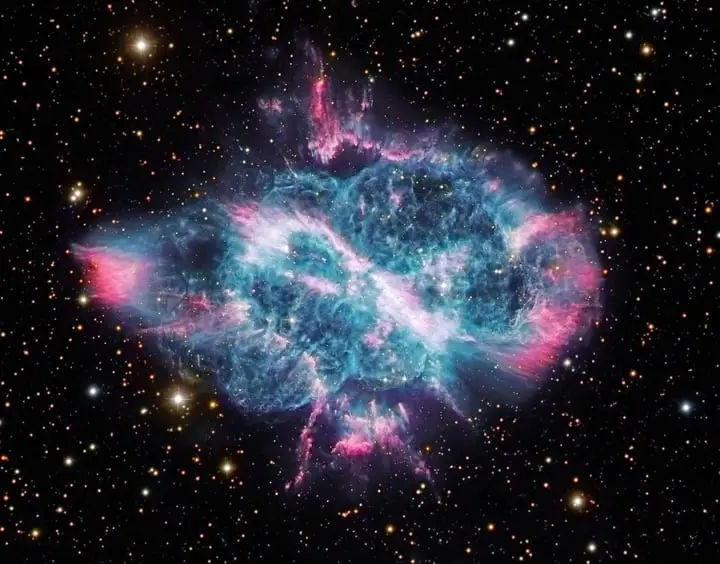
Starship Asterisk
Many can also be dark nebula. These block out light from the stars and galaxies behind them. Some of these come from exploding stars, while others are composed of matter that existed well beforehand. Because these nebulas have such strikingly different compositions, colors, and distributions throughout space, they make up some of the most awe-inspiring images of space.
3. The Helix Nebula
Nicknamed the “Eye of God,” the Helix Nebula is the closest to our galaxy. It lies roughly 700 light years away, drastically closer than anything in the Magellanic Cloud. The cloud is the leftover remnants of an exploded red dwarf star. The resulting view that it provides is that of an ominous human eye.

Planwallpaper
The heat of this nebula is estimated to be around 120,000 degrees Celsius (216,000 degree Fahrenheit). One thing that makes it unique is just how it came to be—the exploded star. Unlike other nebulas, this one came from an exploded low-mass star. What this entails is that it has a different composition of elements.
4. The Eagle Nebula
The Eagle Nebula is a gaseous cloud with a distance of something like 7,000 light-years from Earth. The gas within the nebula, if enough is present, will form stars. Currently, several stars are thought to be forming within it, coalescing into what will be future lights of the night sky.
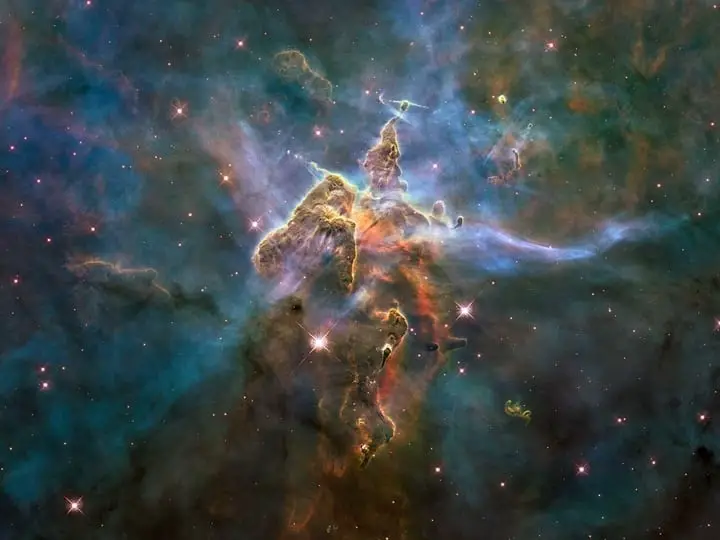
Stern and Weltraum
The nebula is located within a neighboring arm of our Milky Way, oscillating in our same orbit. One interesting fact about this nebula is that parts of its shape have been blown away by a relatively recent—and nearby—supernova. But because the light from this explosion will take a long time to reach us, we might not see the destruction for some time.
5. Hourglass Nebula
The Hourglass Nebula is on its way it, exploding its outer layers in a periodic fashion. These temperamental bursts are responsible for creating the beautiful image we see here—the hourglass. Eventually, this shedding process will result in the star forming a white dwarf star—that is, a dead star with no ability to fuse helium and hydrogen.
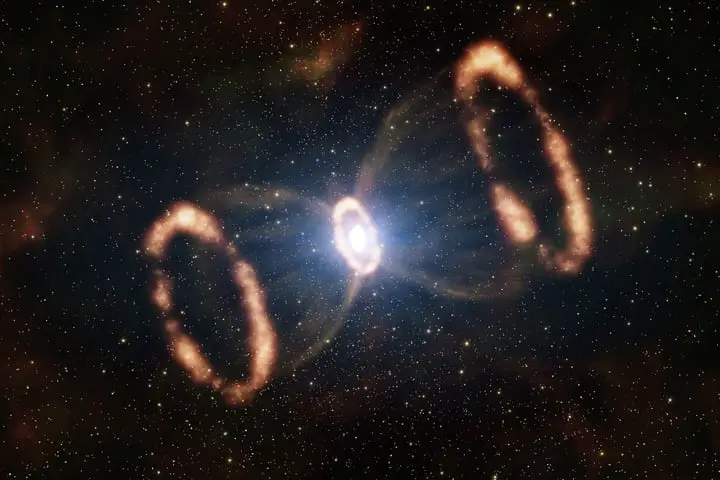
Astronomy
White dwarf stars differ from normal stars in that they undergo no nuclear fusion. Not only that, but they are normally significantly smaller than stars that do undergo nuclear fusion. Another interesting fact about white dwarfs like these is that they didn’t have enough mass to form a neutron star or black hole.
6. Black hole
Black holes are the strongest perturbations in spacetime we know of; they’re wrinkles so bent and contorted and that exert so much gravitational pull that they don’t allow anything—including light, particles, and terrible music—from escaping. This is what makes them so famously black: they suck in everything that enters their warp.
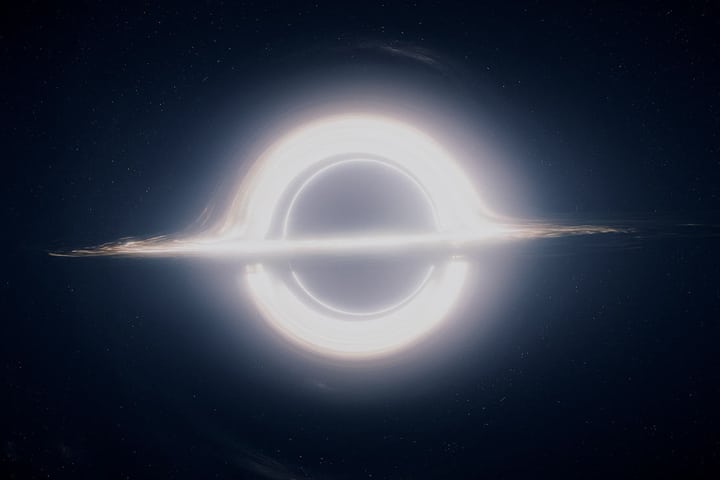
wordlessTech
There is a lot that makes black holes cool. First off, there are many supergiant black holes that lie at the center of galaxies, inducing a severe enough warp in spacetime such to keep an entire galaxy in orbit. Without such supermassive black holes, it’s unlikely that galaxies like our own would be able to thrive.
7. Messier 104: Sombrero Galaxy
The Sombrero Galaxy is a spiral galaxy within the constellation Virgo. It’s a distant 29.3 its center, since there are abundant X-rays and high velocities detected around it. The high velocities suggest a bend in spacetime so severe that everything around it is getting pulled with a very, very strong force.
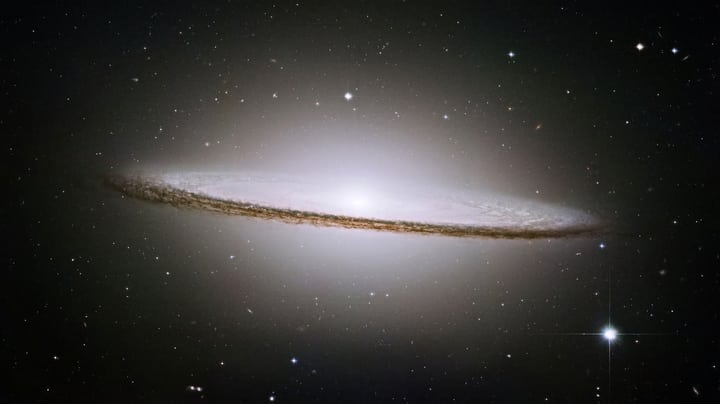
NASA
The galaxy also holds a “dust lane,” which encircles the center of the galaxy. This ring is composed of dust and gases like hydrogen. Interestingly, this gas is thought to be in the midst of forming a few new stars. This galaxy will get a little more star-filled, then, in the years to come.
8. PN M2-9
Also known as the Twin Jet Nebula, this resplendent array of colors is due to streams of gas getting blown from the center star. Amazingly, these streams of gas are getting projected at speeds of around one million kilometers an hour (621,000 miles per hour). That’s pretty fast, in case you were unaware.
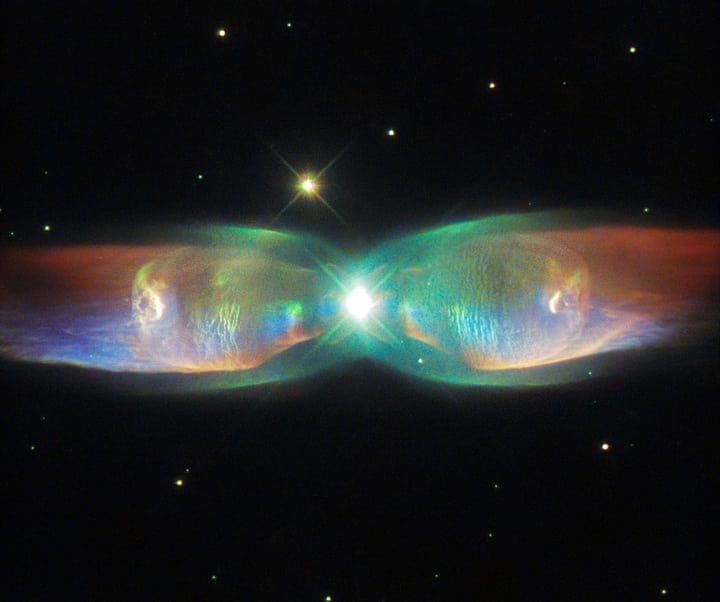
HUBBLE
The iridescent gas from this image tells us about the star’s composition. What it suggests is that the star’s of intermediate mass and in the latter stages of its life; it has ejected its outer layers yet is still creating these luminous streams. This nebula is also bipolar, meaning that instead of one star at its center, it has two.
9. Sharpless 2-106
Sharpless 2-106 is another bipolar star-forming region that lies somewhere around 2,000 light-years from Earth. The colors from this photo are made from different heat signatures—the hotter matter in the foreground with the colder matter in back. This juxtaposition of different heat signatures gives us the beautiful image we see here.
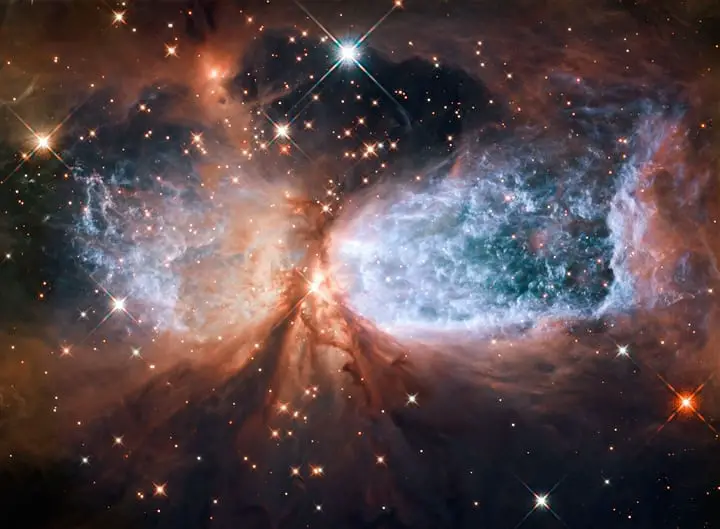
HUBBLE
Not too far from home, this nebula is a part of our very Milky Way. Studies have shown that within the nebula there are many brown dwarfs—stars with too little mass to initiate nuclear fusion. Most of these brown dwarfs weigh less than one-tenth of our Sun. So, they’re not that fun to look at. Sorry.
10. Cat’s Eye Nebula
The Cat’s Eye Nebula has several interesting features about it. First off, its rings are projected out at regular intervals—something like 1,500-year intervals. Second, the amount of dust emitted from the exploding star has a greater mass than all of the planets in our solar system combined. It was, then, a big ol’ star.
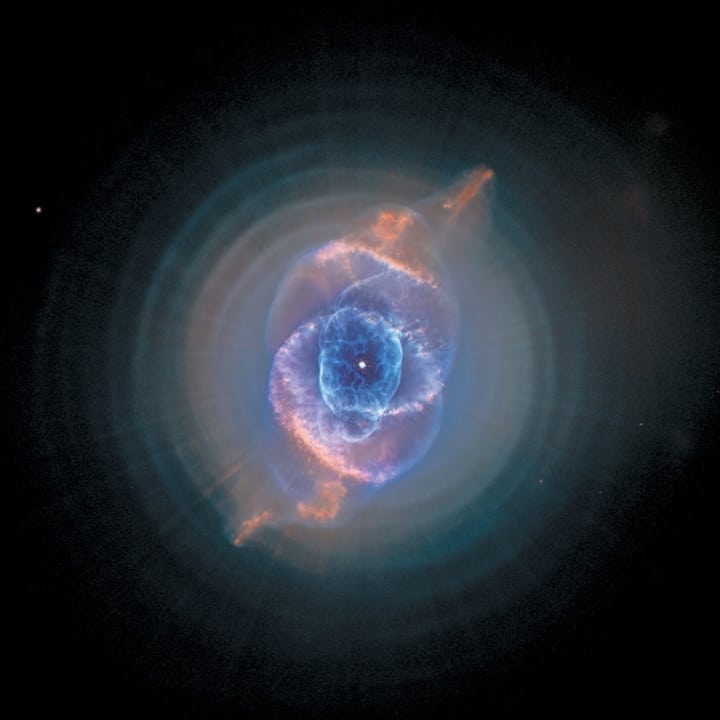
Boing Boing
The interval period with which this star exploded isn’t something astronomers would have predicted. Scientists propose that instead of getting projected in these interval-like patterns, they were instead created seamlessly as they leached into the surrounding space, and only later took on their circular shape. The question isn’t totally resolved, in other words.
11. Tarantula Nebula
The Tarantula Nebula, other than looking like the underbelly of an ugly spider, is a part of the Large Magellanic Cloud (which you’ll read about later). It’s approximately 160,000 light-years away from Earth and considered a “starburst” region. This is because its gas and dust are in the midst of forming a star.
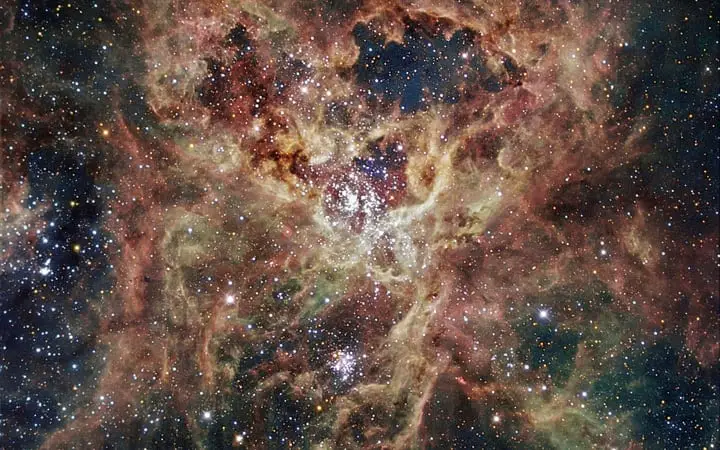
Constellation Guide
Starburst regions are unique, however, in that the rate at which they form stars is far faster than other nebula in the universe. Such regions are likely to usurp all the particles in that area and aggregate them into a mass large enough to form a star. Other, less exciting nebula are slower to form galaxies.
12. NGC 3314
NGC 3314, the image below, is actually two galactic objects—two overlapping spiral galaxies. The galaxy in the background is around 140 million light-years away, while the galaxy at the foreground is around 117 million light-years away. Both, however, illustrate a rare overlap of two giant celestial objects. They also remind us of the strange.
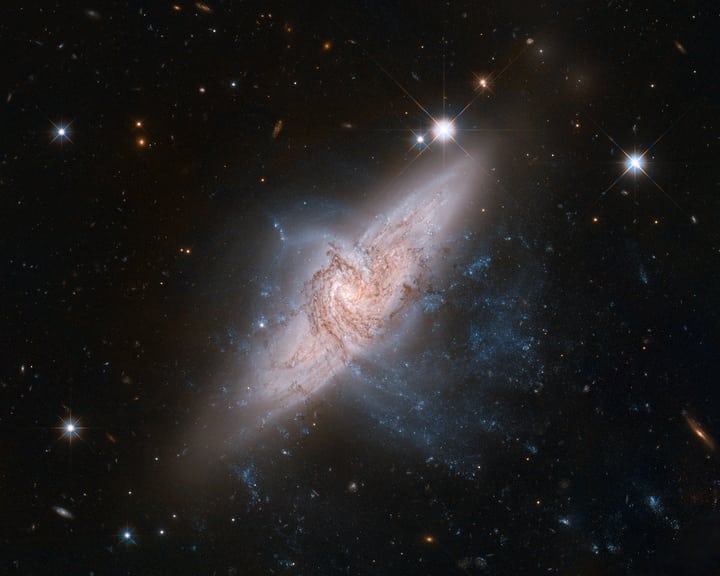
HUBBLE
Both galaxies reside in the Hydra, one of the universe’s many constellations. This unlikely overlap of celestial entities offers a rare and enticing view of a collision to come—even if that collision might not come for another couple hundred million years. So enjoy it while you can, because such an overlap will not exist forever.
13. NGC 6960: The Witch’s Broom Nebula
Another spooky celestial entity is the Witch’s Broom Nebula, which is part of a larger structure called the Veil Nebula. The streams of red and blue were created by a supernova that exploded around 10 thousand years ago. This exploded supernova left the particles in this distinct and unusual broom-like pattern.
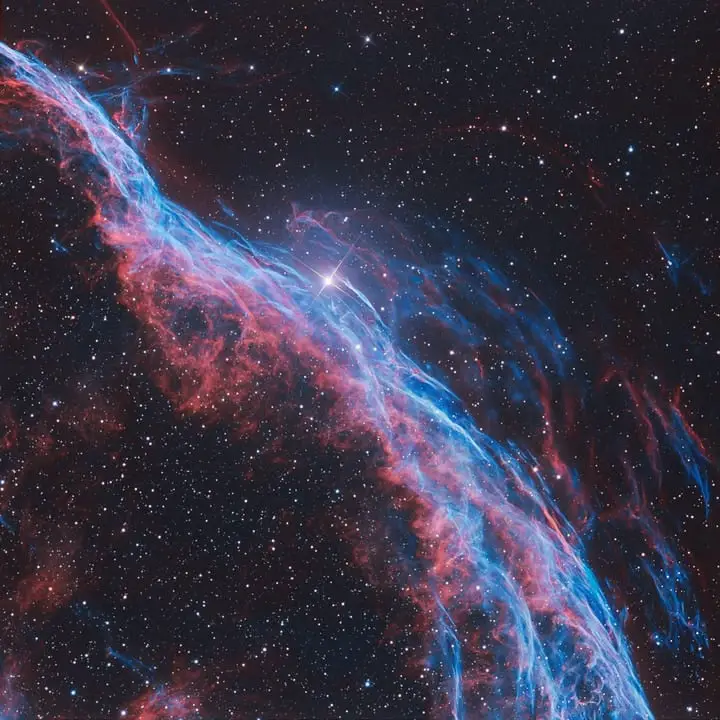
NASA
The red, like with the horseshoe nebula, is created by floating hydrogen atoms, and the blue is created by oxygen. These are, in other words, the two most abundant molecules blown away from this recently demised star. The supernova in its entirety exists within the constellation Cygnus, which is around 1,400 light-years from Earth.
14. The Orion Nebula
The Orion Nebula is another aggregation of dust and space dirt situated within one arm of the Milky Way. Unlike other nebula, however, Orion is bright enough to see with the naked eye. While only certain conditions are conducive to actually seeing it (i.e., low light pollution), it can be found beneath Orion’s Belt.
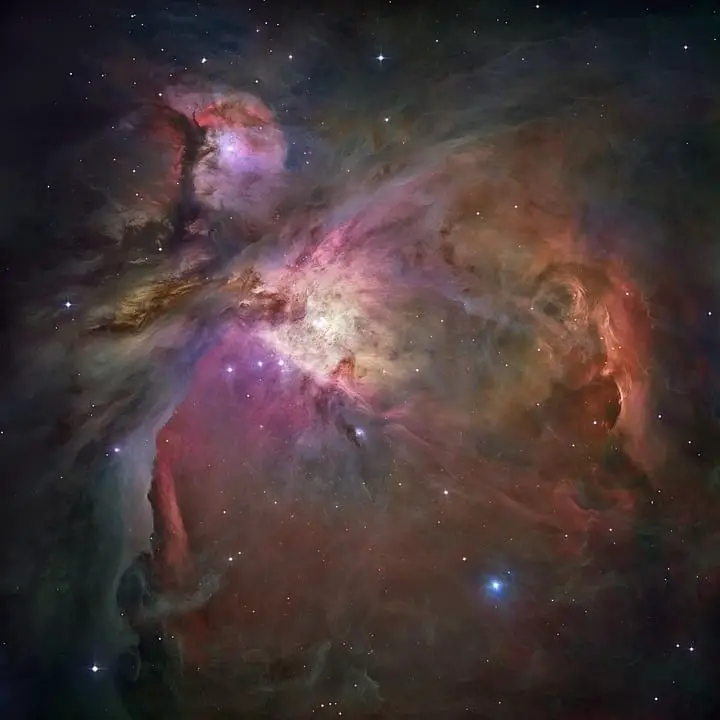
Wikipedia
In aggregate, this nebula has about 2,000 times a greater mass than our Sun. This nebula, because of its brightness, is considered one of the most frequently studied nebula in existence. It is thought to have been the progenitor to many discoveries about how stars are made.
15. Dwarf galaxy (IC-10)
A dwarf galaxy is exactly what a sounds like: a mini-galaxy with well below the average amount of mass and gravitational pull common to other galaxies. Another factor is its number of stars—the fewer, the more dwarfish. IC-10, for example, has somewhere around a couple thousand stars. This makes it a dwarf.
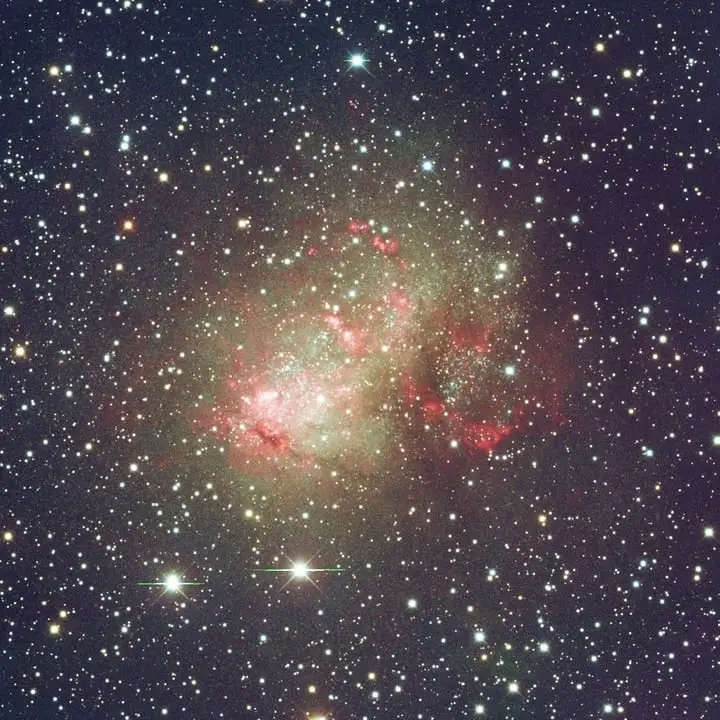
Snipview
When compared to the Milky Way, for instance, this galaxy is severely lacking. The Milky Way has around 200 to 400 billion stars, magnitudes more than this dwarf counterpart. But don’t worry, this dwarf galaxy is heading straight for us and will eventually combine with our own, so we won’t have to ponder its celestial dwarfishness for long.
16. Colliding universes
Much contra to how one might expect a galactic collision to occur, colliding galaxies most likely won’t lead to much turmoil. Instead, the stars inherent to each will likely miss each other. This is because the distance between the stars in each galaxy are so far apart that when they “combine” there is little chance that stars will collide.
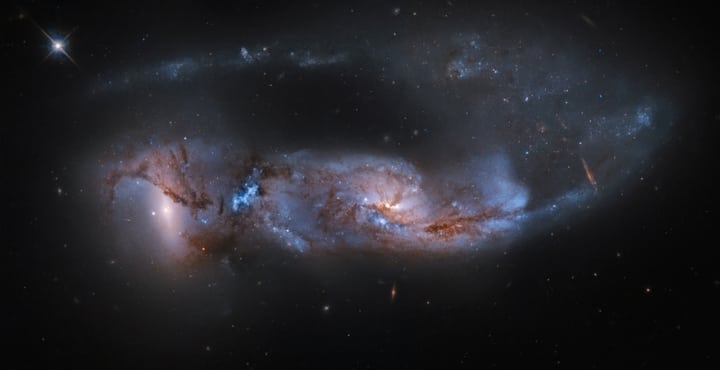
Starship Asterisk
In essence, colliding galaxies won’t be an endless barrage of planet colliding with planet, star colliding with star. Instead, the result will likely be a cannibalistic act: one galaxy consuming the other to make it match its shape. The result will be one parent galaxy that just got a little bit larger.
17. NGC 922
NGC 922 is a barred spiral galaxy that lies about 150 million light years away from Earth. Its impartial ring is the result of a collision with a smaller galaxy around 300 million years ago. The collision sent ripples of gas throughout the galaxy, shaping it into what is now. Maybe in a couple hundred million years it will regain its composure.
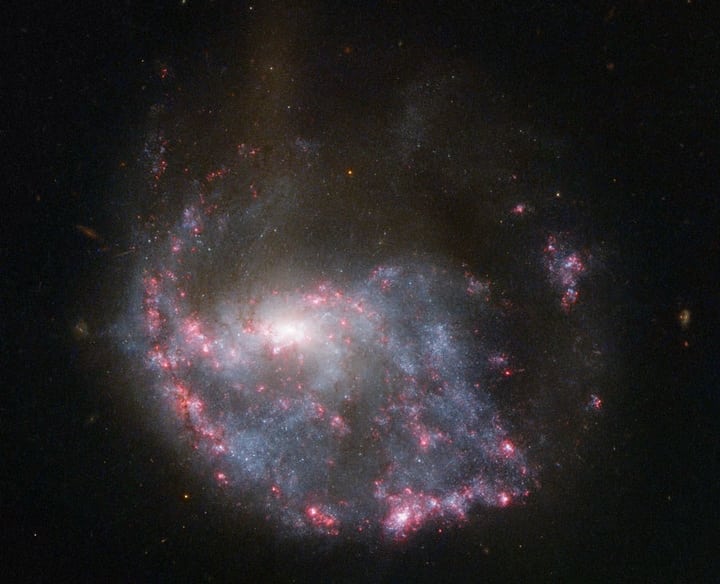
NASA
One thing that makes this galaxy so interesting is the presence of several large black holes within it—which, because of their blackness, you can’t see. Scientists are puzzled because you wouldn’t expect to find such large black holes in tandem with this same abundance and distribution of particles. You would expect, maybe, that they would suck the particles up.
18. (SNR) 0509-67.5
This jellyfish-looking nebula is the result of an ancient exploded star—called, as I’m sure you know, a supernova. This cloud of remnants is around 160,000 light years away from Earth, landing it in the constellation Dorado. Some of the light emitted from this celestial jellyfish indicate that the exploded star held silicon and iron.
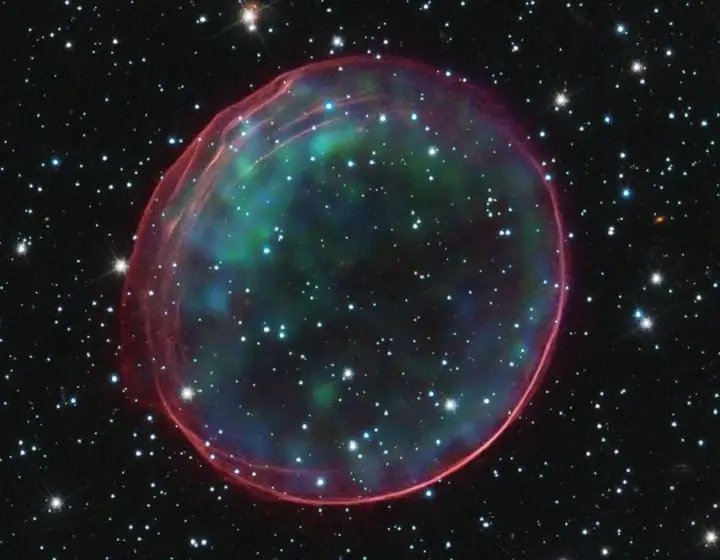
Anne’s Astronomy News
This nebula is considered type 1a, which means that as it exploded it was encircling another star. Either one of both of the stars was likely a white dwarf, a specific breed of star characterized by its density. So while its volume is only comparable to that of Earth, its mass is about as great as our Sun.
19. R136a1
R136a1 is the most luminous and massive star in the universe we know of. It lies in the middle of the Tarantula Nebula, that cluster of particles that resembles the ugly spider underbelly. What makes this star unique—other than its magnificent luminosity and mass—is its uncommon composition. This composition makes it one of the rarer stars in the cosmos.
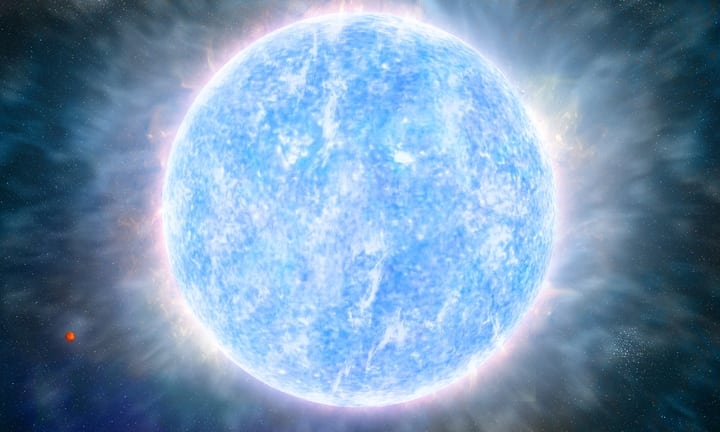
Pistol Star Blue Hypergiant
Unlike other stars, this star is composed of many heavier elements, giving it a different spectral color than those with a lighter density and mass. The star is also significantly larger than our own, with a temperature about 10 times hotter—predicted to be somewhere around 49,000 degrees Celsius (80,000 degrees Fahrenheit).
20. VY Canis Majoris
VY Canis Majoris is technically a red supergiant, another type of star that’s on its way out. These stars are extraordinarily voluminous, yet not necessarily massive or luminous. This red giant in particular is rich in oxygen, which—like the horse nebula we saw in the beginning—contributes to its red color. It’s also a part of Canis Majoris, another major constellation.

TelescopeStargazer
VY Canis Majoris is one of the brightest objects in the sky. It’s around 1,400 to 2,000 times larger than our Sun, and has a volume around three to 10 billion times larger. It makes sense, then, that it would appear so much brighter in the night sky. What doesn’t make sense is how cool it is. Like, seriously.
21. RCS2 032727-132623
This image was taken by the Hubble Space Telescope. What it shows is a galaxy cluster about 10 billion light-years away, making it one of the more distant celestial objects in the night sky. Since the light from this cluster is so old, it gives us a rare opportunity to study galaxy formation when the universe was only one-third its current age.

HUBBLE
One of the more salient features of this image is its clear gravitational lensing. This manifests as a few curved lines around the main cluster of galaxies at the center. For the effect to be as large as it is in this photo, you’d need a massive object like a giant cluster of galaxies or a supermassive black hole.
22. Gravitational lensing
Gravitational lensing is the result of massive objects bending spacetime. This bending causes the light that passes through the warp to take a protracted path, navigating around the massive object. This causes the light to literally blur and bend around the massive celestial object. It is responsible for the blurring we see in many a space photo.
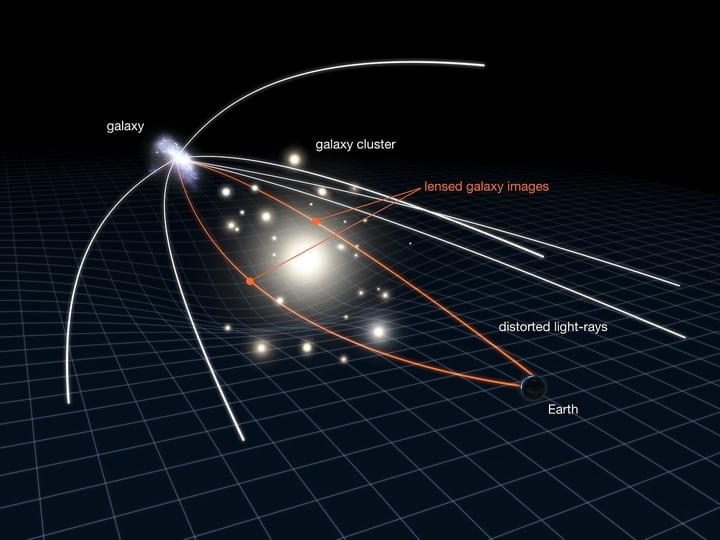
HUBBLE
Because of gravitational lensing, many images of distant stars, galaxies, and the like are blurred together in their travel to Earth. This gives us the smears and blurs characteristic of many images of space. What these smears reveal is an object in space large enough to warp the fabric of spacetime.
23. Spacetime
Spacetime is the way in which time is represented in physical space. Ultimately, this comes down to the amount of mass and energy inherent to the physical objects in space—things like planets, black holes, and galaxies. These dictate the fabric of spacetime, the light that travels through it, and even the way through which things get sucked into black holes.
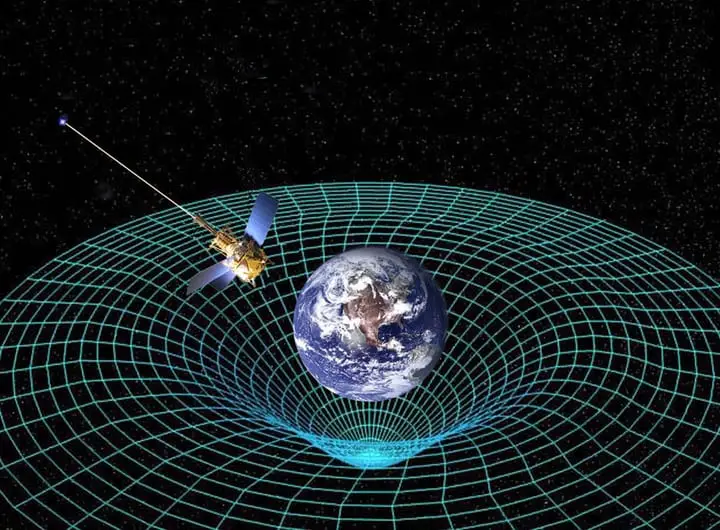
The Why Files
The more mass and energy an object has, the more it will warp the surrounding fabric of spacetime. This warping gives us everything from gravitational lensing to time dilation—the idea that your perception of time changes based off of how much gravity surrounds you. It is, in other words, one of the more interesting celestial phenomena.
24. Hubble Space Telescope
The Hubble Space Telescope launched in 1990. Tragically, one of the mirrors that makes up the telescope was besmirched on this first launch, making it impossible to record any celestial observations. The telescope was repaired, however, bringing solace and ease to the masses. And now, it has given us some of the most breathtaking photos of the cosmos.
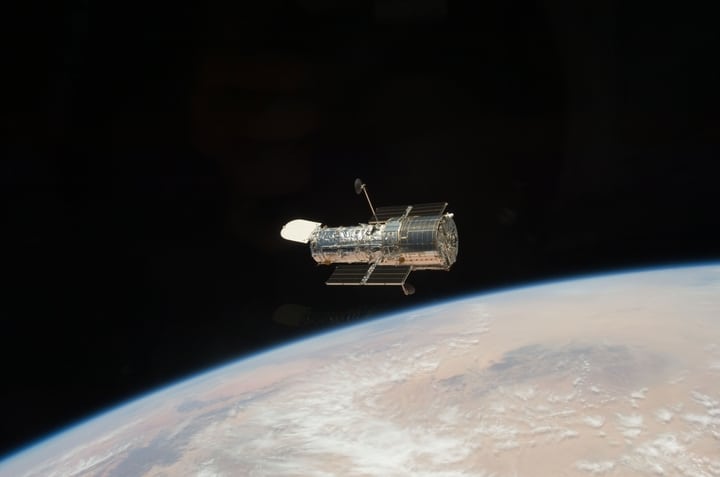
RocketSTEM
Since its initial launch and repair, Hubble has remained healthy and in space, taking many photos that have since melted the public psyche. The most famous photos of the cosmos—many of which are featured here—were taken by Hubble. We have it to thank, then, for some of majesty we get from space and its contents.
25. The Witch Head Nebula
This screaming witch of a nebula is a couple hundred light-years from Earth in the constellation Orion. The image was taken by an infrared telescope, focusing on the infrared parts of the electromagnetic spectrum. While it may look spook on its surface, it is actually just another diffuse nebula.
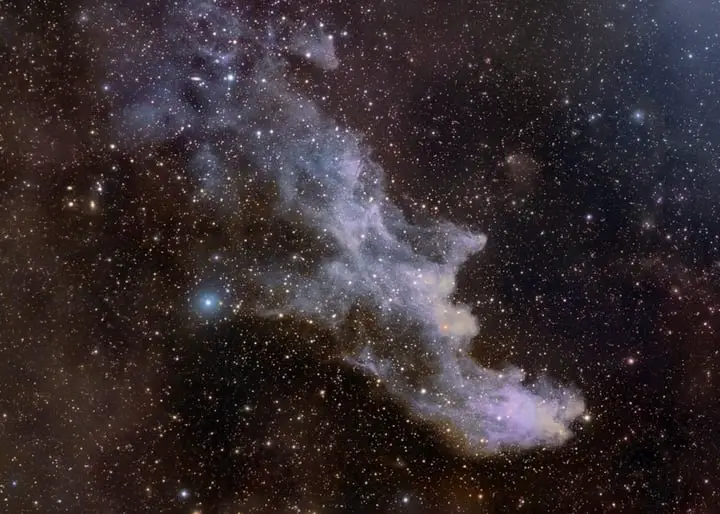
Slate
The reason for the blue tint is that the particles that makes up the witch are better at reflecting blue than any other color of the electromagnetic spectrum. This, like with other elements, suggests something about the nebula’s composition. This is the same type of process that turns our sky that familiar shade of blue.
26. Large Magellanic Cloud
The Large Magellanic Cloud is what astronomers call a “satellite galaxy,” which means that it rotates within the orbit of another, more massive host galaxy. In this case, that galaxy is our very own Milky Way. This nearby cloud of stars and solar systems is unique in several ways. Let’s see how.
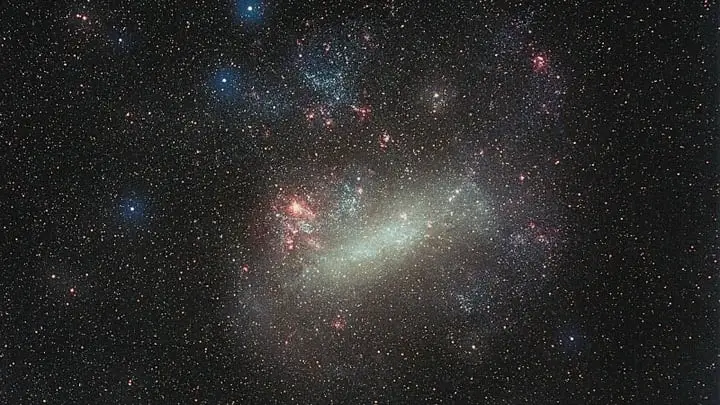
Earth & Sky
The Large Magellanic Cloud is around 160 million light-years away and an estimated 14,000 light-years across. While it’s not the closest galaxy to the Milky Way, it is within the top three. What makes this galaxy so cool is that it literally rotates within the orbit of our Milky Way, making it one of the more familiar celestial objects we know.
27. Karl G. Jansky Very Large Array radio telescope
Unlike Hubble, other telescopes are more terrestrial. The Very Large Array is one such array of telescopes. Based out of New Mexico, this array is made up of 27 telescopes aligned in the shape of a Y. Each telescope is around 82 feet in diameter, making them an interesting sight to see.
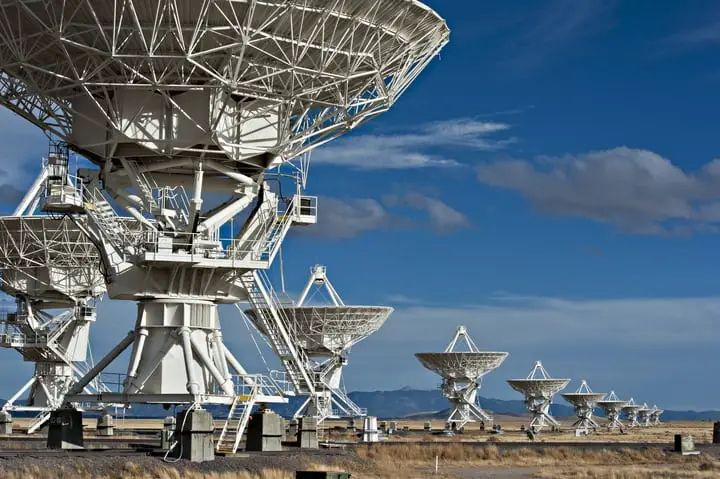
Dunlap Institute
The Very Large Array, unlike Hubble, practices radio astronomy. This subfield of astronomy uses radio waves to determine what they see. Such telescopes are what allowed for the discovery of the cosmic microwave background radiation and other landmark findings in the world of astronomy. They are cool—enough said.
28. Coloration
The coloration in many of these photos is determined by way of assignment. Certain frequencies of light are assigned to a color and then later formatted into something we can see. Others aren’t modified at all, emitting the light they would naturally based off of what element they are primarily composed of.
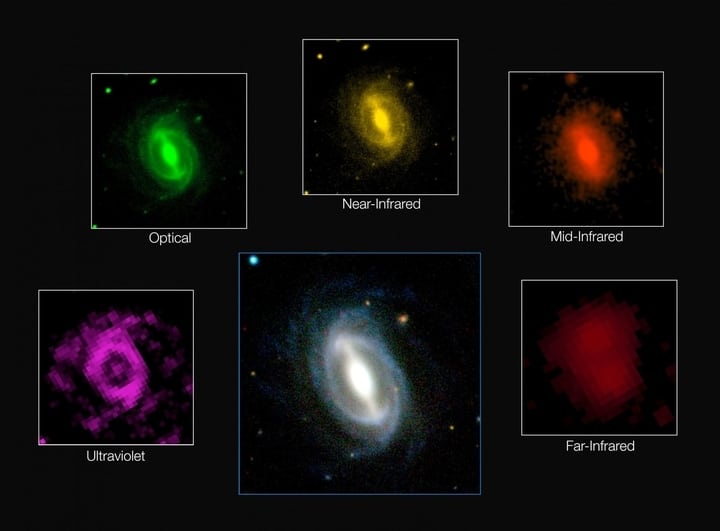
Forbes
Oxygen, for instance, appears blue in the atmosphere, whereas hydrogen appears red. This is all due to way in which these elements reflect and absorb light. So while you look at these photos, you should understand that each of the different colors you see are the result of different types of elements in the void of space.
29. Lagoon Nebula
The Lagoon Nebula is technically an emission nebula. What this means is that it’s formed by ionized gases—i.e., gases that have undergone sufficient radiation to turn them into plasma. (In case you didn’t know, plasma is one of the fundamental states of matter.) Many of these in one place indicates that a star is forming.
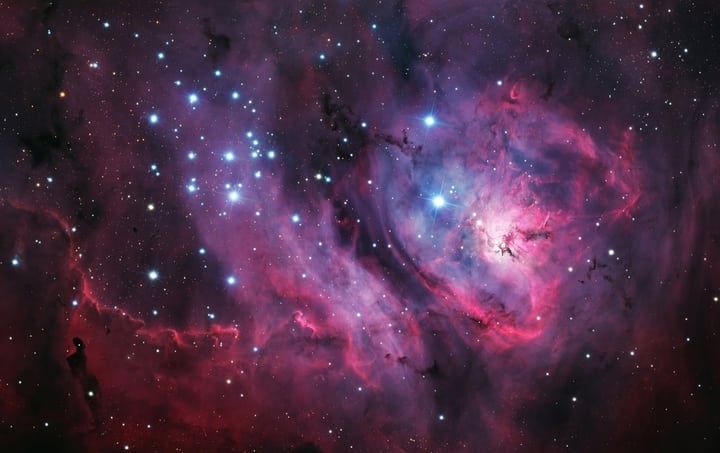
EarthSpaceCircleBlog
The Lagoon Nebula is also easily visible from Earth. But because the human eye is not good at detecting color in low-light conditions, it will appear as nothing more than a boring gray smudge with binoculars. It you have an expensive multi-million dollar satellite, on the other hand, it will appear as vivid and lovely as you see it here.
30. Milky Way
Aside from being the home of you, me, and everyone else we know, the Milky Way galaxy isn’t all that unique. It’s a barred spiral galaxy with clearly defined borders, and it stretches about 100,000 light-years across. Why isn’t it that unique? Because about two-thirds of the known galaxies in our universe are spiral galaxies like our own.
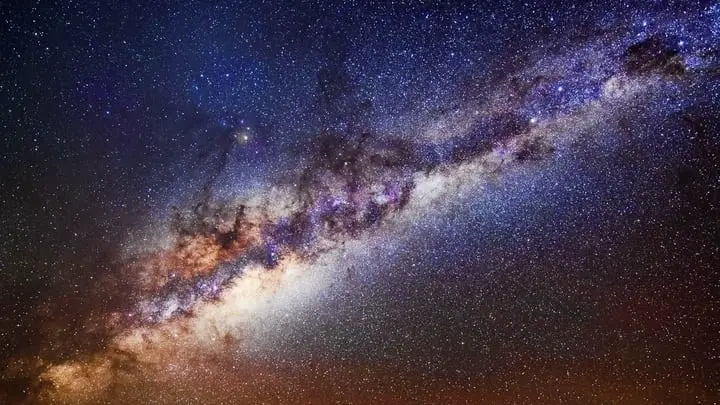
Wallpaper Cave
Roughly, the Milky Way has four arms which hold hundreds of billions of stars each. Two of these arms are smaller than the others. Within our arm of the galaxy, we rotate at a speed of around 828,000 kilometers per hour (515,000 miles per hour). Despite all this normalcy, our galaxy is clearly the best because it contains us.